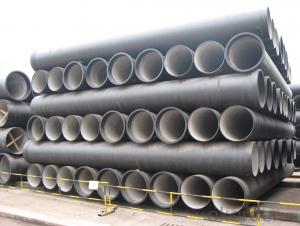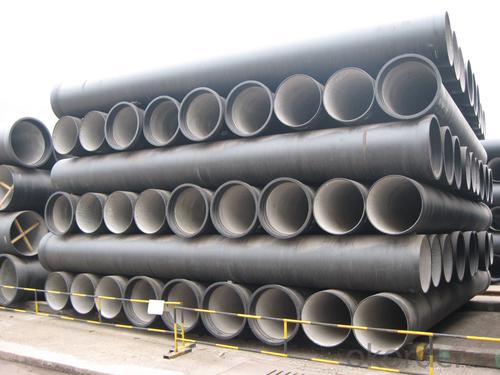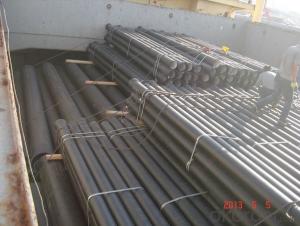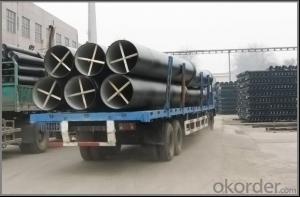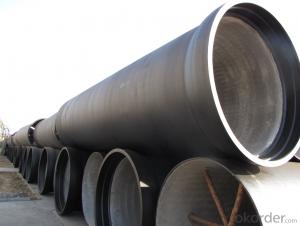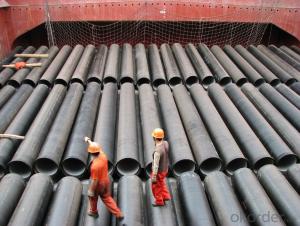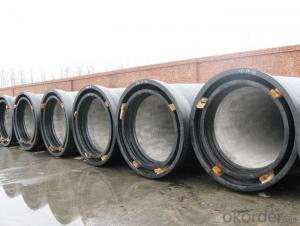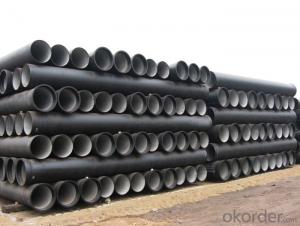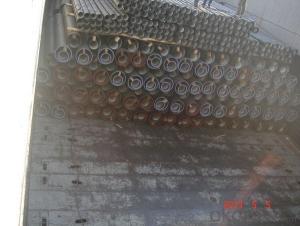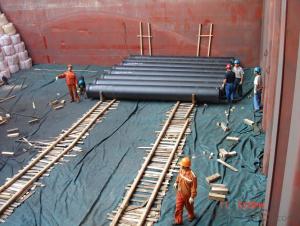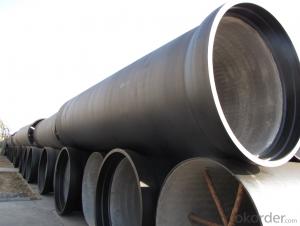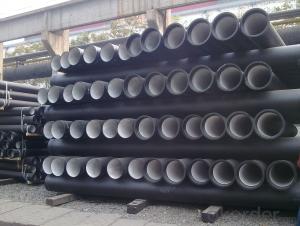EN545 Ductile Iron Pipe Socket Spigot Pipe K9 DN300
- Loading Port:
- Tianjin
- Payment Terms:
- TT OR LC
- Min Order Qty:
- 200 m.t
- Supply Capability:
- 30000 m.t/month
OKorder Service Pledge
OKorder Financial Service
You Might Also Like
1) The standard of pipe: ISO2531:1998, EN545:2006,K9 K8
2) Effective length: 6m/5.7m
3) Inner cement line: Portland cement lineas per ISO4179
4) Zinc coating: at least 130g/m2 as per ISO8179
5) Bitumen painting: at least 70μm as per ISO8179
6)With 102% quantity of NBR, SBR, or EPDM ring asper ISO4633
7) DN80-DN1200
8) Highstrength, lighter than grey iron, good corrosion resistance, no furring, smallflow resistance, easy fixing, long life tome about 100 yeas
9)Checked by automatic inspection equipment
10) Composition:
Chemical composition | |||
Chemical composition | Ductile Cast Iron Pipe (%) | Grey iron pipe (%) | Steel pipe (%) |
C | 3.5-4.0 | 3.2-3.8 | 0.1-0.2 |
Si | 1.9-2.6 | 1.4-2.2 | 0.15-0.4 |
Mn | 0.15-0.45 | 0.4-0.6 | 0.3-0.6 |
P | ≤0.06 | ≤0.3 | 0.02-0.03 |
S | ≤0.02 | ≤0.1 | 0.02-0.03 |
Mg | 0.03-0.06 |
|
|
11) Feature:
Mechanical properties | |||
| Ductile Cast Iron Pipe | Grey Iron Pipe | Steel Pipe |
Tensile Strength(Mpa) | ≥420 | 150-260 | ≥400 |
Yield Strength(Mpa) | ≥300 | No Confirmation | No Confirmation |
Bending Strength(Mpa) | ≥590 | 200-360 | ≥400 |
Elongation (%) | ≥10 | Neglected | ≥18 |
Brinell Hardness(HBS) | ≤230 | ≤230 | About 140 |
12) T type mechanical joint
13) Packing: in bulk or container
PACKING: 1) Pipesare bundled together with the steel belt.
2) Wooden pieces are put between the pipes.
- Q: How does ductile iron pipe perform in high-temperature steam applications?
- In high-temperature steam applications, ductile iron pipe performs admirably. Ductile iron, renowned for its strength and durability, possesses the capability to endure high pressures and temperatures. When subjected to high-temperature steam, ductile iron pipes retain their structural integrity and are not easily deformed or cracked. They possess a remarkable resistance to thermal expansion and contraction, rendering them suitable for situations where temperature fluctuations are common. Furthermore, ductile iron pipes exhibit exceptional corrosion resistance, a crucial characteristic in steam applications where the presence of moisture can accelerate corrosion. All in all, ductile iron pipes are a dependable choice for high-temperature steam applications, delivering enduring performance and ensuring the secure and efficient transportation of steam.
- Q: The benefits of ductile iron castings
- Nodular cast iron has developed rapidly to be second only to grey cast iron and widely used as cast iron material. The so-called "iron instead of steel", mainly refers to ductile iron
- Q: What is the expected hydraulic efficiency of ductile iron pipes?
- The expected hydraulic efficiency of ductile iron pipes is generally high, as they have a smooth interior surface that minimizes friction and allows for efficient flow of water or other fluids.
- Q: Can ductile iron pipes be used in areas with high groundwater levels?
- Indeed, areas with high groundwater levels can accommodate the use of ductile iron pipes. Renowned for their robustness, endurance, and anti-corrosion properties, these pipes prove themselves suitable for diverse purposes, such as water supply systems. Their structural integrity remains intact even when confronted with elevated groundwater levels. Additionally, the smooth interior surface of ductile iron pipes aids in sustaining optimal flow capacity while minimizing the likelihood of blockages or sediment accumulation. Thus, they offer a dependable option for regions with considerable groundwater levels, ensuring a durable and effective resolution for water distribution systems.
- Q: How does ductile iron pipe perform in areas with high ground movement?
- Ductile iron pipe performs well in areas with high ground movement due to its inherent flexibility and strength. Its ability to bend and absorb ground movements makes it less susceptible to cracking or breaking compared to other rigid pipe materials. Additionally, the material's high tensile strength and durability ensure that it can withstand the stresses caused by ground movement without compromising its structural integrity.
- Q: What are the typical joint restraint requirements for ductile iron pipes in seismic zones?
- Ductile iron pipes in seismic zones require joint restraints to guarantee structural integrity and prevent displacement or separation during seismic events. These requirements are essential for maintaining the functionality and reliability of the pipeline system. In seismic zones, one common joint restraint requirement for ductile iron pipes is the utilization of flexible or mechanical joint systems. Flexible joints, like rubber gasket joints, are capable of absorbing and accommodating seismic movement. These joints allow for axial movement, angular deflection, and pipe expansion/contraction, thereby reducing the likelihood of pipe failure or damage. Another crucial requirement involves employing adequate anchoring systems to secure the pipes to surrounding structures or embed them in concrete thrust blocks. This prevents excessive movement or displacement during seismic events. Anchoring systems help distribute earthquake forces and minimize the risk of pipe separation or breakage. Moreover, seismic design standards often necessitate the use of seismic restraints, such as seismic joint restraints or bracing systems, to further enhance the stability and integrity of ductile iron pipes. These restraints restrict pipe movement in specific directions, thereby reducing potential damage and preserving overall system performance. It is important to acknowledge that specific joint restraint requirements for ductile iron pipes in seismic zones may vary based on local building codes, seismic activity levels, and engineering considerations. To ensure compliance with necessary seismic resistance requirements, it is crucial to consult relevant regulations and work with experienced professionals during the design and installation process.
- Q: How can the cast iron pipe be connected?
- Drain pipe or water supply pipe?. The drainage tube as stated on the first floor, water supply pipe of T type and K type and S type, currently dominated by T, a lot of Xinxing Pipes as well, when connecting with T type rubber ring socket socket into the brand, after inserted with oil. The installation team is generally safe.
- Q: What if the ductile iron pipe is broken?
- Ductile iron pipe rupture can be repaired by using a cast iron defect repair machine, that is, a cast iron defect repair device. However, the general use of iron defects repair equipment can be repaired welding, and will not affect its use. Ductile iron pipes are used for water supply, so if it breaks, it will not be easy to handle. Make sure that the main valve is closed and repaired.
- Q: What kind of joints are used with ductile iron pipe?
- Mechanical joints or push-on joints are commonly utilized with ductile iron pipe. Mechanical joints involve a gland and a rubber gasket for connecting pipes. These joints are fastened using bolts or other mechanical methods to ensure a secure and tight connection. On the contrary, push-on joints do not demand bolts or extra hardware. They only require the insertion of a rubber gasket into the socket of the pipe, resulting in a sealed connection. Both types of joints are extensively employed with ductile iron pipe, providing dependable and leak-proof connections for diverse applications.
- Q: Do ductile iron pipes require special maintenance?
- Yes, ductile iron pipes do require special maintenance. While ductile iron is known for its strength and durability, it is still susceptible to certain forms of corrosion. Regular maintenance is necessary to prevent corrosion and prolong the lifespan of the pipes. This maintenance typically includes periodic inspections to check for any signs of corrosion or damage, as well as cleaning and protective coating applications. Additionally, proper handling and installation techniques should be followed to ensure the integrity of the pipes. Regular maintenance and adherence to industry best practices can help prevent leaks, breaks, and other issues, ultimately saving time and money in the long run.
Send your message to us
EN545 Ductile Iron Pipe Socket Spigot Pipe K9 DN300
- Loading Port:
- Tianjin
- Payment Terms:
- TT OR LC
- Min Order Qty:
- 200 m.t
- Supply Capability:
- 30000 m.t/month
OKorder Service Pledge
OKorder Financial Service
Similar products
Hot products
Hot Searches
Related keywords
